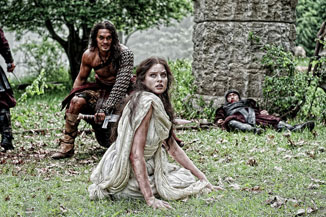|
|
Book vs. MovieConan the BarbarianBy Russ BickerstaffAugust 24, 2011
There’s more. There’s some magic here. And thanks to modern CGI special effect, it looks a lot more impressive than, say, scars suddenly appearing on a villain as mirrors are shattered or the raising and lowering of a wall found in the second film. (Honestly, it hardly seems like they tried with Conan The Destroyer.) In a more impressively-framed drama, this could’ve been staged as a really nice spectacle, but it’s used as kind of a cheap throwaway gag here to add atmosphere without adding any real significance. It’s a competently-rendered film, but hardly the kind of cinematic genius befitting the character who ushered in a whole new era of fantasy fiction. The Verdict There’s no mistaking that Robert E. Howard’s character was a commercial creation, appearing in popular pulp fiction of the early ‘30s, but there was a kind of fresh fusion between old legends and new perspectives on fiction in an emerging market. The character took hold in the imaginations of people just beginning to understand the meaning of being human in an increasingly technological 20th century - an era where everybody probably felt a little bit primitive. As the character evolved through the work of subsequent authors, he changed. By the time a young bodybuilder became synonymous with the character, he’d lost much of the edge he had in those 1930s stories. We find ourselves in an era where the multiplex bears some passing resemblance to an early 20th century newsstand with countless disposable dreams to sink into. Pay some money to the person behind the counter and go somewhere else for a little while before returning to your life. Robert E. Howard’s original stories had a resonance to them that could breeze to life through pulp paper in a wholly refreshing way. None of the three films that have attempted to commit the character to the screen have managed the commercial alchemy needed to capture the same kind of energy found in those original stories.
[ View other Book vs. Movie columns ]
[ View other columns by Russ Bickerstaff ]
[ Email this column ]
|

|
|
|

|
Friday, November 1, 2024
© 2024 Box Office Prophets, a division of One Of Us, Inc.


